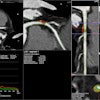Monday, December 2 | 12:15 p.m.-12:45 p.m. | VI226-SD-MOA3 | Lakeside, VI Community, Station 3
In this presentation, researchers from the U.S. National Institutes of Health (NIH) will discuss the potential advantages of a smartphone-based augmented reality (AR) application that they designed to facilitate CT-guided percutaneous needle placement.The group, led by Ming Li, PhD, developed the AR application using computer and AR programming software. The application allows clinicians to display their planned needle trajectory in real-time using a smartphone (iPhone 7, Apple).
The researchers tested their AR application on a phantom containing multiple target beads embedded as deep as 16 cm, as well as a reference marker registered to the phantom's preprocedural CT scan. Two interventional radiologists performed three needle insertions on the phantom using the AR application for image guidance and the traditional CT-guided method.
Overall, AR guidance led to statistically significant reductions in procedure time, compared with traditional CT guidance (p < 0.05). In addition, the AR method did not require the acquisition of CT scans.
The findings show that AR-guided needle insertion with a smartphone could help reduce patient radiation exposure and procedural time, Li and colleagues noted. The AR method may also be a viable option for guiding percutaneous procedures when conventional real-time imaging is not available.



















